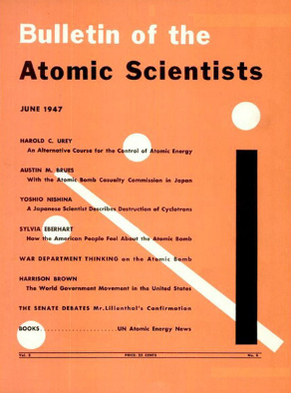 Originally posted on the Time of Encounter Blog, part of an AHRC-funded project looking at time in social life. If, as I suggested in my previous post, our everyday clocks obscure the politics involved in their production, there are also a wide variety of clocks that have been explicitly developed to intervene into the political. These clocks do not tell the story of a homogeneous, unending and all-encompassing time, but instead provoke us to re-examine our assumptions about time itself. The first couple of examples I want to focus on in this series intervene into the notion of an undifferentiated future and instead suggest that the end of time might actually be very close to the present. Arguably of the most prominent example of this type of clock is the Doomsday Clock. Created in 1947 by the Bulletin of the Atomic Scientists, it tracks the likelihood of nuclear war. Using a traditional clock-face, the clock re-purposes the minute hand so that it no longer indicates the accumulated changes in the ceasium atom (which is the basis of atomic time) but instead indicates changes in the prevalence of atomic bombs and their likelihood of use. Giving new meaning to the concept of ‘atomic time’, the clock was developed in the early stages of the cold war in order to “frighten men [sic] into rationality” according to Eugene Rabinowitch, one of the co-founders of the Bulletin. Thus while still using the design of the standard clock, this version undoes UTC’s soothing projection of a future without end through a refocusing on the very real possibility of armageddon. In one of the few academic articles about the clock, Juha Vuori suggests that the continued use of the standard design was crucial to lending believability to clock that was more prophetic that precise. He argues that “through the symbol of the Doomsday Clock, the Scientists have been able to combine their social capital as voices of reason and objectivity with that of the soothsayer to influence society and behaviour” (Vuori, 2010 264) Going back to the redefinition of the clock that I proposed in my first post, the Doomsday clock illustrates really nicely the notion that clocks should not be understood simply as devices for telling the time, but as devices for coordinating with what is significant. It initially sought to focus attention on the specific context in 1947. But, although originally designed to be simply a static image, in 1949 the Doomsday Clock was moved forward from seven minutes to midnight to just three minutes in response to the first Soviet tests of the atomic bomb. Later the changing political context led to the clock being moved back back to seven minutes to midnight in 1960. This adds an extra dimension to its disruption of clock time, providing the possibility of time to move forward or backward depending on the political context and human action or inaction. But further it shows the importance of continuing to track significant change when attempting to tell the time. As part of this, later changes to the clock included incorporating an analysis of the threats of climate change and biological weapons. Indeed, the clock was moved forward one minute to midnight in January 2012 in part due to inaction over climate change. (See here for an outline of the changing times of the clock). One thing that the Doomsday Clock suggests, then, is that if you want your clock to remain significant it has to keep with the times. However, what can also be learnt is the difficulty of doing so. A common criticism has been that the clock did not move at all during the Cuban missile crisis, but stayed at seven minutes to midnight throughout. The attempt to make the clock more relevant by considering a variety of global threats could also strain the reach of its symbolism. Further, inspired by the Doomsday Clock the Atlantic decided to develop an Iran War Clock, only to remove all mention of it from its website soon after with no initial explanation. (Although this is now available). Even so, as one online commentator suggests: “whenever you’re curious how near humanity is to destroying itself, you can check the status on the Doomsday Clock homepage. It’s good to stay abreast of this sort of thing so you can plan your schedule around it.” |
Archives
November 2022
Categories
All
|
 RSS Feed
RSS Feed
